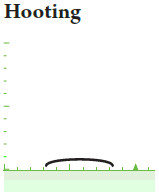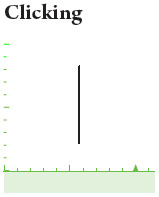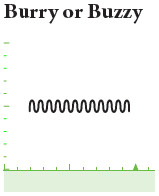The Seven Basic Tone Qualities
Nothing has created more confusion about how to describe sounds than tone quality.
Tone quality is the distinctive voice of a sound — the thing that allows you to tell the difference between a violin and a trumpet when they’re both playing the same note. It comes in very handy when identifying birds by sound, but people have tended to differ in their notions of how to describe it. Today, we’re going to break sounds down into just seven basic qualities, which in combination make up the huge variety of sounds that birds can create.
And here they are:
 |
 |
 |
|
 |
 |
 |
 |
Whistled sounds
Whistles are the most basic and common type of bird sound. They appear on the spectrogram as simple nonvertical lines. Non-bird sounds with a whistled tone quality include typical human whistling, and the sounds of flutes and piccolos. Bird examples are plentiful:
Hooting sounds
Hoots and coos are just low-pitched whistles, less than 1 kHz in frequency, that appear at the very bottom of the spectrogram. They resemble the sound made by blowing across the top of an open bottle, and they are typical of the voices of doves and large owls.
Clicking sounds
Instantaneous bursts of noise sound like clicks, pops, or taps, and appear on the spectrogram as vertical lines. The ticking of a clock, the drumming of a woodpecker’s bill against a tree, the bill snap of an angry flycatcher, and the ticking song of Yellow Rail all fall into this category.
Burry and buzzy sounds
When a whistle rises and falls very rapidly in pitch, it forms a squiggly line on the spectrogram and sounds trilled, like a referee whistle. If the squiggles are tall and fast enough, they sound less musical, more like an electric buzzer. What all burrs and buzzes have in common is the presence of very rapid repeated elements, resulting in audible “beats”. This makes them very similar to (and in some cases indistinguishable from) trills.
The beats in burry and buzzy sounds are often so rapid that they are not individually visible on the spectrogram. The result is a well-defined shape on the spectrogram that is vertically thicker than the thin line of a whistle. Such sounds often have a hoarse, grating quality to the ear.
Noisy sounds
Noisy sounds contain noise—that is, random sound at multiple frequencies, which looks like television static on the spectrogram and sounds like static to the ear. Unlike buzzes, noisy sounds tend to have faded, blurry edges on the spectrogram, and they often almost stretch all the way to the bottom and the top of it.
Non-bird sources of noise include rushing streams and waterfalls, and the English speech sounds “s” and “sh”. Noisy bird sounds tend to be described as “rough” or “harsh,” like the alarm chatters of wrens and the hissing of angry swans and geese.
Nasal sounds
Many bird sounds are actually combinations of multiple simultaneous whistles on different pitches that the human brain typically perceives as a single sound (because of the mathematical relationship between the frequencies of the different whistles). This is characteristic of the sounds we identify as having a nasal tone quality. The individual whistles are called partials. Non-bird examples include police sirens, the whine of mosquito wings, and the sounds of oboes and violins.
Polyphonic sounds
Many birds can produce two separate sounds simultaneously, one from each lung. When birds use this ability, the two original sounds blend into one polyphonic sound. Polyphonic sounds are diverse, encompassing a number of different tone qualities, but with practice, they can be consistently distinguished from all other types of sounds by ear.
On the spectrogram, polyphonic sounds may look like nasal sounds, with stacks of partials, but if the spectrogram is high enough in quality, they can usually be distinguished by having partials that are dissimilar in shape, irregularly spaced, or simultaneously rising and falling.
The quality of most polyphonic sounds is either distinctively metallic or distinctively whiny.
metallic: If the polyphonic notes are very brief or contain monotone segments, they tend to sound metallic, like certain versions of the Hooded Oriole call, some versions the “squeaky gate hinge” songs of Brewer’s Blackbird and Common Grackle, and the shimmering melodies of thrushes like the Veery.
whiny: If the polyphonic notes do not contain any monotone segments, they tend to have a whiny quality, like the Pine Siskin and Blue-gray Gnatcatcher calls, as well as the common calls of House Finch and the flight calls of meadowlarks.
Obviously, these seven tone qualities are very broad categories. Some of them grade into one another, and some of them occur in combination — e.g., a note may be simultaneously burry, noisy, and nasal. But this is the basic vocabulary we’ll use to start discussing the qualities of sounds. More to come!